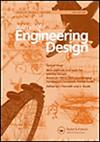设计余量评价与探索的多目标稳健性指标
IF 3.4
2区 工程技术
Q1 ENGINEERING, MULTIDISCIPLINARY
引用次数: 0
摘要
摘要设计余量的确定是为了减轻工程设计过程中普遍存在的不确定性。本文解决了两方面的挑战:在设计过程的早期,在设计成熟到足以进行详细建模之前,建立一个合适的边际概念,并评估边际相互依赖性。由于保证金通常以非结构化的方式指定,因此存在一个保证金可能导致需要更多保证金的风险,例如下游的严格公差。为了避免不利的边际依赖,提出了基于多目标设计探索的5个多目标鲁棒性指标:相对乌托邦指数、相对帕累托形状指数、相对妥协指数、相对平均敏感性指数和平均可行变量范围。它们集合了设计配置的最优性、权衡和敏感性。这些指标被应用到一个案例,一个平头坦克设计,以说明影响和相互依赖的余量规格。确定了三种边缘类型。第一种类型只影响目标空间大小,第二种类型只影响帕累托集合大小,第三种类型影响帕累托集合形状。第三种边距类型是最关键的,因为它会导致在设计过程后期更难在设计目标之间做出妥协。关键词:设计余量稳健设计多目标优化作者感谢诺和诺德对DTU-NN稳健设计项目的财政支持。披露声明作者未报告潜在的利益冲突。注1关于平均有效函数计算的详细概述fjeff(x)。我们参考(Deb and Gupta Citation2006)Sigurdarson等人(Citation2022a, Citation2022b)介绍了系统性权衡缓解领域的进一步工作。本研究得到了诺和诺德的支持。本文章由计算机程序翻译,如有差异,请以英文原文为准。
Multi-objective robustness indicators for evaluation and exploration of design margins
AbstractSpecification of design margins serves the purpose of mitigating the ubiquitous uncertainty of the engineering design process. This paper addresses the twofold challenge of establishing a suitable concept of margins early in the design process, before the design is mature enough for detailed modelling, and evaluating margin inter-dependencies. As margins are often specified in an unstructured manner, there is a risk that one margin might lead to a need for more margins, e.g. tight tolerances, downstream.To avoid adverse margin dependencies, five Multi-Objective Robustness Indicators based on multi-objective design exploration are presented: The Relative Utopia Index, the Relative Pareto Shape Index, the Relative Compromise Index, the Relative Average Sensitivity Index, and the Average Feasible Variable Range. They aggregate optimality, trade-offs and sensitivity of design configurations. The indicators are applied to a case example, a flat head tank design, to illustrate the effect and inter-dependency of margin specification.Three margin types were identified. The first type affects only the Objective Space size, the second type affects only the Pareto set size and the third type affects Pareto set shape. The third margin type is the most critical as it leads to harder compromises between design objectives later in the design process.KEYWORDS: Design marginsRobust designMulti-objective optimisation AcknowledgementThe authors would like to thank Novo Nordisk for financial support to the DTU-NN Robust Design program.Disclosure statementNo potential conflict of interest was reported by the author(s).Notes1 For a detailed overview of the calculation of mean effective functions fjeff(x). we refer to (Deb and Gupta Citation2006).2 Further work in the area of systematic trade-off mitigation is presented by Sigurdarson et al. (Citation2022a, Citation2022b).Additional informationFundingThis work was supported by Novo Nordisk.
求助全文
通过发布文献求助,成功后即可免费获取论文全文。
去求助
来源期刊

Journal of Engineering Design
工程技术-工程:综合
CiteScore
5.00
自引率
33.30%
发文量
18
审稿时长
4.5 months
期刊介绍:
The Journal of Engineering Design is a leading international publication that provides an essential forum for dialogue on important issues across all disciplines and aspects of the design of engineered products and systems. The Journal publishes pioneering, contemporary, best industrial practice as well as authoritative research, studies and review papers on the underlying principles of design, its management, practice, techniques and methodologies, rather than specific domain applications.
We welcome papers that examine the following topics:
Engineering design aesthetics, style and form-
Big data analytics in engineering design-
Collaborative design in engineering-
Engineering concept design-
Creativity and innovation in engineering-
Engineering design architectures-
Design costing in engineering
Design education and pedagogy in engineering-
Engineering design for X, e.g. manufacturability, assembly, environment, sustainability-
Engineering design management-
Design risk and uncertainty in engineering-
Engineering design theory and methodology-
Designing product platforms, modularity and reuse in engineering-
Emotive design, e.g. Kansei engineering-
Ergonomics, styling and the design process-
Evolutionary design activity in engineering (product improvement & refinement)-
Global and distributed engineering design-
Inclusive design and assistive engineering technology-
Engineering industrial design and total design-
Integrated engineering design development-
Knowledge and information management in engineering-
Engineering maintainability, sustainability, safety and standards-
Multi, inter and trans disciplinary engineering design-
New engineering product design and development-
Engineering product introduction process[...]
 求助内容:
求助内容: 应助结果提醒方式:
应助结果提醒方式:


